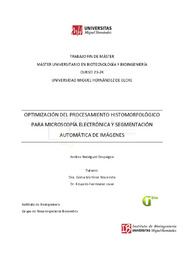Please use this identifier to cite or link to this item:
https://hdl.handle.net/11000/33326Full metadata record
| DC Field | Value | Language |
|---|---|---|
| dc.contributor.advisor | Martínez Navarrete, Gema | - |
| dc.contributor.advisor | Fernández Jover, Eduardo | - |
| dc.contributor.author | Rodríguez Despaigne, Andrea | - |
| dc.contributor.other | Instituto de Bioingeniería | es_ES |
| dc.date.accessioned | 2024-09-27T12:27:18Z | - |
| dc.date.available | 2024-09-27T12:27:18Z | - |
| dc.date.created | 2024-09 | - |
| dc.identifier.uri | https://hdl.handle.net/11000/33326 | - |
| dc.description.abstract | En el campo de la neurobiología, la optimización de los protocolos histológicos es fundamental para obtener resultados precisos y fiables en el análisis de tejidos nerviosos. Este trabajo se enfocó en mejorar los métodos de fijación y contraste utilizados en el procesamiento histomorfológico del nervio ciático de ratas, un modelo clave en estudios del sistema nervioso periférico. Se demostró que el uso del glutaraldehído, solo o en combinación con el paraformaldehído, es efectivo para la preservación de las estructuras nerviosas. En lo que respecta al contraste, la combinación de osmio reducido con ferricianuro de potasio y tiocarbohidrazida resultó ser más eficaz para teñir las vainas de mielina, aunque presentó limitaciones en la penetración hacia zonas más profundas del tejido. Además, se identificaron desafíos en la precisión de la segmentación automática de axones debido a la calidad del contraste, lo que indica la necesidad de ajustes adicionales tanto en los protocolos experimentales como en el entrenamiento de los algoritmos. | es_ES |
| dc.description.abstract | In the field of neurobiology, the optimization of histological protocols is fundamental to obtain precise and reliable results in the analysys of nervous tissue. This work focused on improving the fixation and contrast methods used in the histomorphological processing of the rat sciatic nerve, a key model in studies of the peripheral nervous system. It was demonstrated that the use of glutaraldehyde, either alone or in combination with paraformaldehyde, is effective for the preservation of nervous structures. Regarding contrast, the combination of reduced osmium with potassium ferricyanide and thiocarbohydrazide proved to be more effective for staining myelin sheaths, although it presented limitations in penetration into the deeper regions of the tissue. Additionally, challenges were identified in the accuracy of automatic axon segmentation due to contrast quality, indicating the need for further adjustments in both experimental protocols and algorithm training. | es_ES |
| dc.format | application/pdf | es_ES |
| dc.format.extent | 49 | es_ES |
| dc.language.iso | spa | es_ES |
| dc.publisher | Universidad Miguel Hernández de Elche | es_ES |
| dc.rights | info:eu-repo/semantics/openAccess | es_ES |
| dc.rights | Attribution-NonCommercial-NoDerivatives 4.0 Internacional | * |
| dc.rights.uri | http://creativecommons.org/licenses/by-nc-nd/4.0/ | * |
| dc.subject | Histología | es_ES |
| dc.subject | Fijación | es_ES |
| dc.subject | tetraóxido de osmio | es_ES |
| dc.subject | Contraste | es_ES |
| dc.subject | nervio ciático | es_ES |
| dc.subject | segmentación automática | es_ES |
| dc.subject.other | CDU::5 - Ciencias puras y naturales::57 - Biología | es_ES |
| dc.title | Optimización del procesamiento histomorfológico para microscopía electrónica y segmentación automática de imágenes | es_ES |
| dc.type | info:eu-repo/semantics/masterThesis | es_ES |
| dc.contributor.institute | Institutos de la UMH::Instituto de Bioingeniería | es_ES |

View/Open:
Andrea Rodriguez Despaigne.pdf
29,34 MB
Adobe PDF
Share:
.png)
